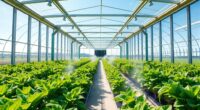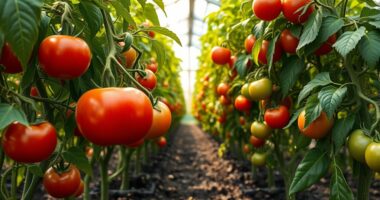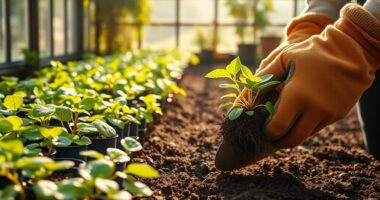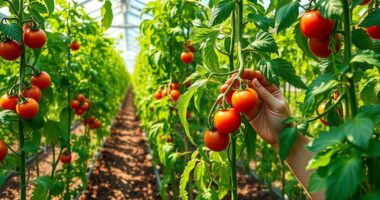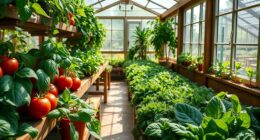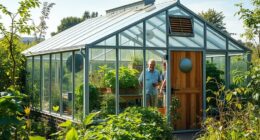Greenhouse gardening for cut flowers can be rewarding. Start by testing your soil to verify it has the right pH and nutrients. Choose easy annuals like zinnias or marigolds, along with some perennials for variety. Maintain proper greenhouse conditions with appropriate lighting and ventilation, and remember to harvest flowers at the right time for longer vase life. With proper techniques and care, you'll create a thriving flower garden. There's so much more to discover about maximizing your greenhouse success!
Key Takeaways
- Select easy-to-grow flowers like zinnias and marigolds, which thrive in greenhouse conditions for cutting purposes.
- Ensure soil pH is between 6.0 and 7.5 for optimal flower growth and quality.
- Implement regular soil testing and fertilization techniques to maintain nutrient-rich soil.
- Manage greenhouse climate with adequate ventilation and lighting to promote healthy flower development.
- Harvest flowers early in the day, using clean tools, and store them in cool water for longevity.
Soil Preparation for Flower Growing
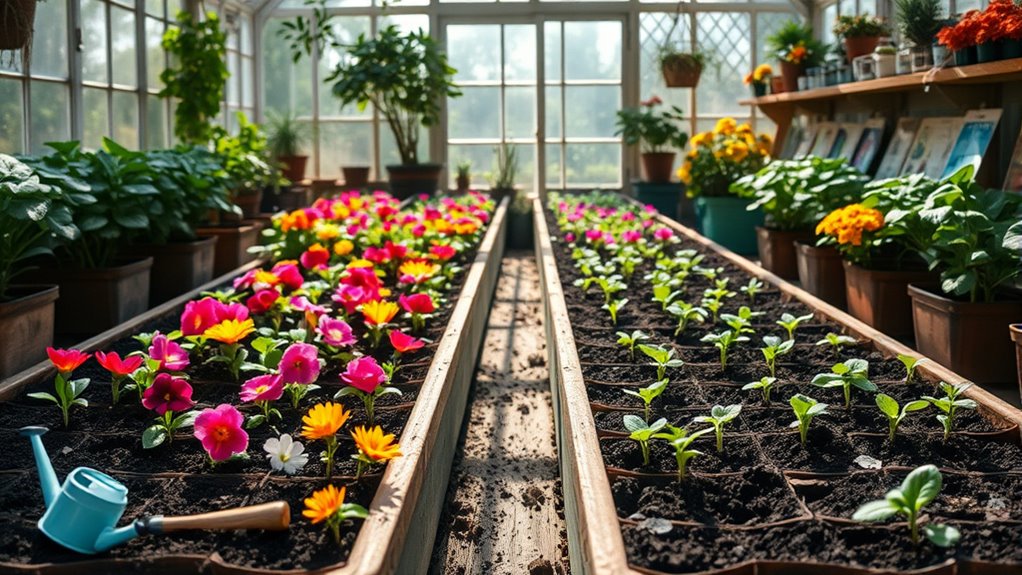
When you're preparing soil for growing flowers, it's vital to start with soil testing and analysis. This step helps you understand nutrient and pH levels, which are essential for ideal growth. You can use inexpensive kits or consult local garden centers for testing.
Most flowering plants thrive in soil with a pH between 6.0 and 7.5. Once you know your soil's composition, you can add appropriate amendments. Work the soil while it's moist to maintain its structure, using a shovel or garden fork to loosen compacted areas and remove debris.
Incorporate organic matter, like compost, to boost fertility and drainage. Remember, regular testing guarantees your soil stays fertile and balanced over time, setting the stage for vibrant blooms.
Selecting the Right Flowers

Selecting the right flowers for your cutting garden can make all the difference in creating stunning arrangements. Start with easy-to-grow annuals like zinnias, sunflowers, and marigolds for vibrant blooms. Raw food diets can provide inspiration for seasonal varieties that thrive in your garden. Foraging for wild edibles can also inspire unique floral arrangements with natural elements.
Consider perennials such as blazing star and salvia for their long-lasting beauty. If space allows, biennials can add unique blooms but require more time. Select flowers suited to your hardiness zone and climate; for instance, celosia thrives in heat, while sweet peas prefer cooler conditions. Additionally, incorporating folate-rich flowers like certain varieties of marigolds may enhance the nutritional value of your arrangements. Look for flowers with long stems and extended bloom durations, like cosmos.
Incorporate a mix of colors and textures for visual interest, and include fragrant varieties like roses to elevate your arrangements. Additionally, planning for continuous blooms guarantees your garden stays lively all season long, much like the importance of selecting the right cold medication for effective relief during seasonal changes.
Effective Soil and Fertilization Techniques
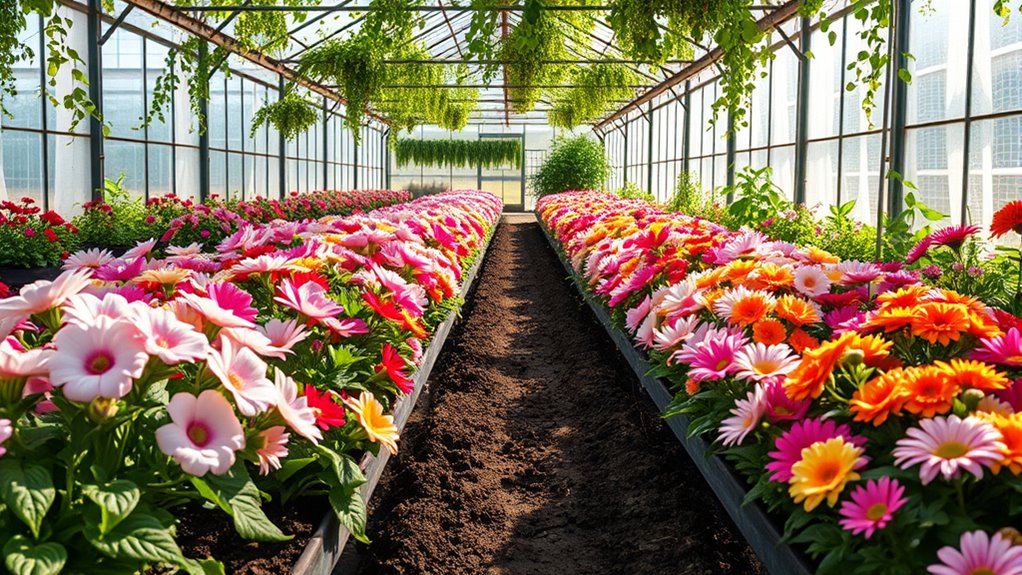
To grow vibrant cutting flowers, effective soil and fertilization techniques are essential. Start with regular soil testing to understand nutrient composition and pH levels, ensuring ideal conditions for your flowers. Aim for slightly acidic to neutral soil, enriched with organic matter like compost to enhance both structure and fertility.
For fertilization, consider split applications of nitrogen to maintain a steady nutrient supply, particularly in well-drained soils. Use balanced fertilizers, timing applications according to plant growth stages.
Mulching can conserve moisture and suppress weeds, while crop rotation helps maintain soil fertility. Don't forget to aerate the soil and prevent compaction to support healthy root growth.
These practices will set you up for successful flower production.
Managing Greenhouse Climate and Lighting
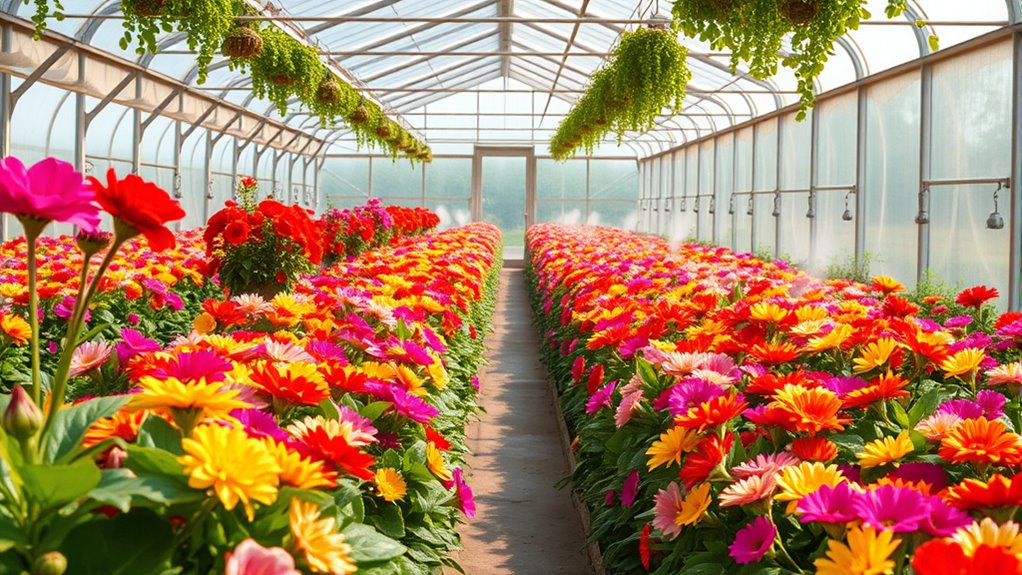
Managing the climate and lighting in your greenhouse is vital for growing healthy cutting flowers. Choose a structure that fits your needs, like glass for better light and heat retention. Use ventilation systems to prevent overheating during warm months and guarantee supplemental heating in colder climates.
High ceilings promote airflow, reducing hotspots and improving plant health.
Natural sunlight is essential for photosynthesis, but don't hesitate to use shade cloth to manage light intensity. In low-light conditions, additional artificial lighting can help.
Maintain peak temperatures, especially at night, to enhance flower quality. By effectively controlling these elements, you can create an ideal environment that promotes robust growth and beautiful blooms for cutting.
Harvesting and Handling Cut Flowers

After creating an ideal climate for your greenhouse flowers, the next step is harvesting and handling them properly to guarantee their beauty and longevity.
Harvest flowers early in the morning or late afternoon to minimize water loss. Use sharp, clean cutting tools and cut stems at a 45-degree angle for better water absorption. Aim for long stems to extend vase life, and remove any foliage that will sit below the waterline.
Harvest flowers during cooler parts of the day, using sharp tools and cutting stems at an angle for optimal hydration.
Immediately place cut flowers in clean, cool water. Use warm water with floral preservative to enhance hydration.
Store them in a cool environment with high humidity to prevent dehydration. Regularly inspect your flowers for quality, and transport them in protective packaging while maintaining cool temperatures to make certain they arrive fresh.
Ongoing Maintenance for a Thriving Greenhouse
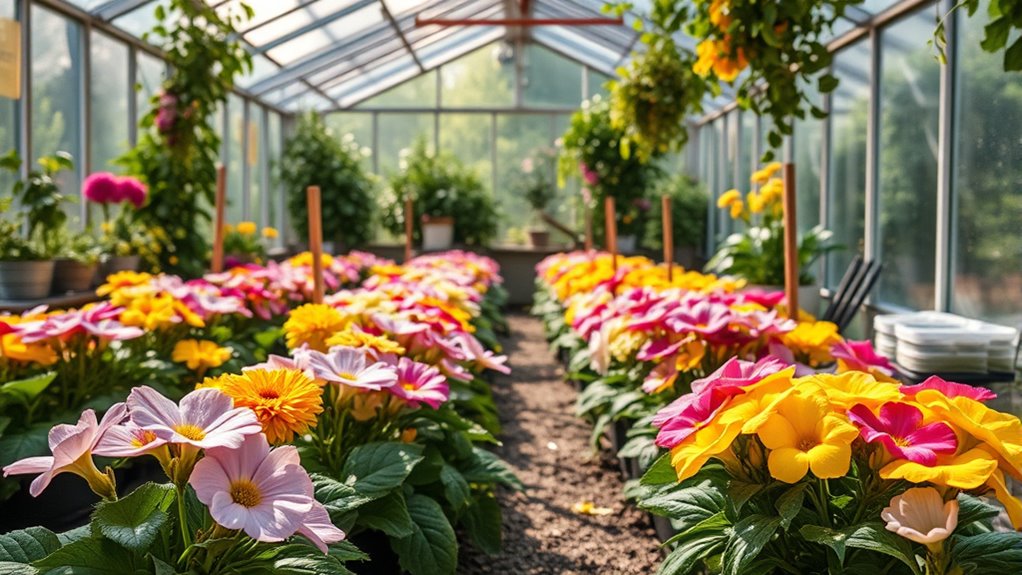
While creating a thriving greenhouse environment is essential, ongoing maintenance guarantees your flowers flourish year-round.
Regularly clean the interior to remove plant debris and disinfect surfaces, preventing disease spread. Don't forget the exterior; clean it at least twice a year to maximize light transmission.
Monitor climate conditions with hygrometers and use shade cloths to protect against excessive heat. Conduct pest inspections frequently and adopt organic controls to keep infestations at bay.
Maintain your equipment by lubricating moving parts and confirming ventilation systems work properly.
Finally, inspect the greenhouse structure for damage and seal gaps to maintain climate control.
Frequently Asked Questions
What Flowers Attract Beneficial Insects for Pollination?
To attract beneficial insects for pollination, consider planting lavender, bee balm, and coneflowers.
These flowers provide abundant nectar, enticing honeybees and bumblebees.
Marigolds and sunflowers add vibrant colors, drawing in various pollinators.
For butterflies, plant milkweed, phlox, and lantana.
Incorporating alyssum and yarrow will attract hoverflies and other helpful insects.
How Do I Protect Flowers From Extreme Weather Conditions?
To protect your flowers from extreme weather conditions, use shade cloth to shield them from intense sunlight, reducing heat stress.
Implement windbreaks and stake your plants to prevent wind damage. Cover them with tarps during heavy rain, and consider using frost cloths during cold snaps.
Additionally, mulching can insulate roots against freezing temperatures, while moving delicate plants to a greenhouse guarantees they thrive year-round, regardless of external weather challenges.
Can I Grow Cut Flowers in Containers?
Absolutely, you can grow cut flowers in containers! Picture your patio as a blooming oasis, filled with vibrant colors.
Choose containers with good drainage and a size that suits your space. Do some soil testing, mix in compost, and select easy-to-grow flowers like zinnias or snapdragons.
Keep an eye on sunlight and water them properly. Deadhead regularly, and you'll have a stunning supply of blooms ready for cutting and showcasing!
What Common Pests Should I Watch for in My Greenhouse?
In your greenhouse, you should watch for common pests like aphids, whiteflies, thrips, spider mites, and fungus gnats.
Look for signs like visible colonies, stippled leaves, and small flies around the soil.
To manage these pests, inspect your plants regularly, maintain good air circulation, and practice sanitation.
Consider using biological controls, like predatory mites, and employ sticky traps to monitor flying pests.
Staying vigilant will help keep your plants healthy and thriving.
How Often Should I Rotate Flower Crops in My Garden?
You should rotate your flower crops at least once a year to keep pests and diseases at bay.
Ideally, aim for a rotation every growing season to maintain soil health and fertility. If you're growing annuals, consider changing their location each spring.
Conclusion
In your greenhouse, vibrant blooms stand in contrast to the quiet, nurturing soil beneath them. As you cultivate a sanctuary of colors, remember that each flower you cut represents both the effort you've poured in and the beauty you'll share. With diligent care and attention, your flowers will flourish amidst the controlled climate, bringing joy to both your space and those who receive your stunning arrangements. Embrace the cycle of growth, and let your passion blossom.

